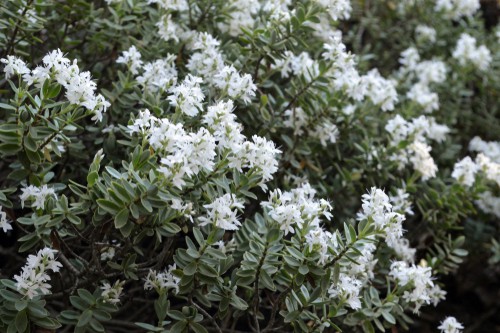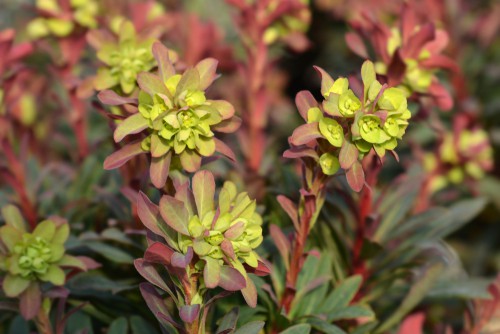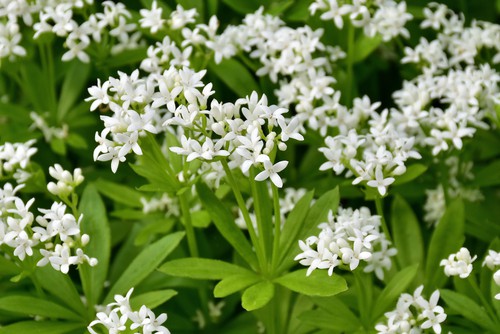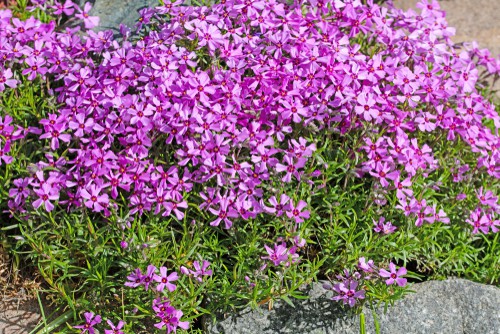Our site is reader supported, this means we may earn a small commission from Amazon and other affiliates when you buy through links on our site.
In my 20 years as a professional gardener, working in my family’s garden centre and in clients’ gardens, I’ve come to appreciate the value and beauty that evergreen groundcover plants bring to the landscape. I’ve also come to understand their role in sloped gardens where traditional planting isn’t always convenient. I’ve previously discussed fast-growing groundcover plants as well as groundcover plants in general, so in this guide, I wanted to focus on evergreen groundcover plants that provide colour all year round.
For me, they also play a crucial role in suppressing weeds. They also help in dispersing snow as it melts, preventing soil erosion and water loss, and they act as a natural mulch, allowing the soil to retain moisture, which is essential for the health of your garden. Additionally, they are perfect for filling in gaps.

Among my personal favourites I’ve included in my guide are the Ophiopogon planiscapus which is a black grass with its unique dark foliage; Bergenia cordifolia, known for its robust and glossy leaves; Hebe pinguifolia, a very hardy shrub; Pachysandra terminalis, another shrub and a classic choice for shady areas; and Vinca minor with its delicate flowers with its sprawling habit.
These plants, along with other evergreen groundcovers, including shrubs, perennials, and rockery plants, have not only survived but thrived in my gardens, providing year-round interest and solving numerous landscaping challenges.
Below are the 12 of my favourite evergreen plants that are suitable for groundcover to add to your garden:
1. Ophiopogon planiscapus (Black mondo grass)

- Growing Conditions: Prefers moist, well-drained soil; tolerates a range of soil types; drought-tolerant once established.
- Position and Aspect: Best in partial shade; can tolerate full sun in cooler climates.
- Eventual Size: Grows to 15-25 cm (6-10 inches) high and wide; slow-growing, clump-forming habit.
Ophiopogon planiscapus, commonly known as black mondo grass, is actually one of my favourite plants and is a unique and visually striking option for evergreen ground cover. Its deep, almost black leaves provide a dramatic contrast to the more traditional greens found in gardens, making it a favorite among gardeners looking to add depth and intrigue to their landscape design. This plant is not only prized for its aesthetic appeal but also for its hardy nature and low maintenance requirements, making it an ideal choice for both novice and experienced gardeners alike.
Black mondo grass thrives in a variety of conditions, preferring partial to full shade and well-draining soil, which allows it to be a versatile choice for different garden settings. It grows to a modest height of about 6 to 10 inches, forming dense clumps that spread slowly, providing an effective ground cover that suppresses weeds and requires minimal upkeep. This plant is also drought-resistant once established, further reducing the need for frequent watering and care. Beyond its utility and ease of care, Ophiopogon planiscapus blooms with small, purplish flowers in the summer, followed by dark berries, adding seasonal interest and attracting wildlife to the garden. Its resilience and year-round beauty make black mondo grass an excellent choice for gardeners looking to create a low-maintenance, yet visually captivating groundcover.
2. Bergenia cordifolia

- Growing Conditions: Thrives in moist, well-drained soil; adaptable to various soil types.
- Position and Aspect: Prefers partial shade but can tolerate full sun if moisture is sufficient.
- Eventual Size: Reaches up to 30-45 cm (12-18 inches) in height and spread.
Bergenia cordifolia is a bit of a strange one as it’s a versatile evergreen perennial that is an excellent groundcover plant. Perennials are typically thought of as plants that die back in winter, but Bergenia doesn’t. What I like about this plant is its ability to thrive in a wide range of climates and its tolerance for both full sun and shade, making it perfect for most gardens.
The plant is named for its large, glossy, heart-shaped leaves, which provide a lush, green backdrop year-round while in early to mid-spring, it produces striking clusters of pink to deep magenta flowers upon tall stems. They are also a good choice as they attract pollinators, including bees, so you know you’re doing your part.
Because of its dense growth habit, it also helps suppress weeds, reducing the need for constant weeding.
3. Hebe pinguifolia ‘Pagei’

- Growing Conditions: Prefers well-drained soil; drought-tolerant once established.
- Position and Aspect: Thrives in full sun to partial shade.
- Eventual Size: Grows to about 30 cm (12 inches) tall by 90cm (3ft) wide.
This evergreen shrub produces simple leaves and flower spikes that lead to flowers come summer and autumn. This is actually a very low-growing dwarf evergreen so it’s perfect for regions where you want an evergreen groundcover option that doesn’t reach too high, especially if it is planted amongst other shrubs.
It will reach upwards of 30cm in height and spread to create a dense mat of 90cm in width. The leaves take on a silver-grey, blue-toned display all year round and this is offset by the white flowers in spring and summer.
It does quite well with full sun or partial shade and like many of the evergreen groundcover plants on this list, it will grow effectively in all manner of soils, including chalk, clay, sand and loam as long as it’s moist and well-drained. It also tolerates a range of alkalinity and neutral soils.
I’ve also written a guide on fast growing evergreen shrubs that might be worth a read
4. Pachysandra terminalis – Japanese Spurge

- Growing Conditions: Prefers moist, well-drained soil; tolerant of a wide pH range.
- Position and Aspect: Best in partial to full shade.
- Eventual Size: Reaches 20-30 cm (8-12 inches) in height with a spreading habit.
This plant is best grown in rich, well-drained soil. It prefers partial shade and full sun so will grow well where other plants may struggle due to lack of light. However, if it is exposed to too much sun the otherwise green foliage will start to look bleached, so it does best in terms of the beautiful display if it gets dappled shade which is why many gardeners plant them underneath big trees.
You can use it effectively as a groundcover and it will spread to form large colonies. Within these colonies, you can enjoy the evergreen leaves throughout the winter and the showy flowers that bloom white in April. These tiny white flowers appear on spikes and they draw the eye and create a wonderful backdrop for your garden.
This plant is extremely popular when used for groundcover in shady locations. It’s perfect on banks or slopes, underneath trees, along pathways or amongst other shrubs in your garden.
5. Vinca minor – Periwinkle

- Growing Conditions: Tolerates a range of soils; prefers well-drained conditions; drought-tolerant once established.
- Position and Aspect: Thrives in full sun to full shade.
- Eventual Size: Grows to about 10-20 cm (4-8 inches) tall with a spreading habit.
If you need a tough, low-maintenance groundcover option, this is it. It’s known for its creeping habit and will very quickly overtake an area, it is a great alternative to Pachysandra for those looking for a matt forming groundcover shrub.
Also known as the Common Periwinkle or the Creeping Myrtle, when it is fully established it will reach no more than 20cm tall with a spread upwards of 45cm wide. It will do well in partial shade or full shade, making it fairly flexible.
It’s quite tolerant of all soil types including normal soil, sand soil, clay soil, neutral soil, alkaline and acidic soils. The only real requirement when it comes to the soil is proper drainage. When you plant them you can space them about 30cm apart in order to get them to fill in an area quickly. Once they reach maturity they are a rather drought tolerant plant. Because of their ability to spread quickly, they are very effective in holding your soil in place, which can be a critical component if you have a sloped garden and you are combating issues of soil erosion.
One of the most attractive features of this plant is the flowers that are produced between May and June. Depending on the variety you can enjoy delightful blue, lavender, purple and even white flowers, some of which are rich in their shading on the exterior and white in the centre near the stamen.
6. Stachys byzantina – Lambs Ears

- Growing Conditions: Prefers well-drained soil; drought-tolerant once established.
- Position and Aspect: Best in full sun.
- Eventual Size: Reaches 30-45 cm (12-18 inches) in height and spread.
Lamb’s Ear is a colourful form of groundcover that offers soft, greyish-green leaves. It’s known for its thick and velvety leaves in particular. In warmer climates the leaves are evergreen and they will spread rapidly to create a mat of leaves approximately 15cm off the ground.
That makes it effective for low to the ground covering. It is quite tolerant of rabbits and deer, air pollution, rocky soil, dry soil, even drought so it really is a robust plant. Once it’s planted there is very little maintenance required of you. The only issue to which they are susceptible is leaf spot, when there is too much moisture so you need to be careful not to overwater and that the soil is free-draining.
There are flowers that appear between May and July but they are small, purple in colour and some gardeners class them as insignificant. In fact, many gardeners remove the flowering stems so that the beautiful sea of grey-green leaves is not interrupted.
7. Ajuga reptans – Common Bugle

- Growing Conditions: Thrives in moist, well-drained soil; tolerates a wide range of soil types.
- Position and Aspect: Prefers full sun to partial shade.
- Eventual Size: Grows to about 10-15 cm (4-6 inches) tall with a spreading habit.
Known as the Common Bugle, this plant is easily grown in well-drained soil that gets full sun or partial shade exposure and is a firm favourite for rockeries.
It will tolerate moderately dry soils but it does, however, prefer moist soil. That being said providing optimum conditions will increase the flower production you receive and the colours therein. While the plants will grow well in any other conditions you might not receive the same brightness. This plant needs good air circulation and can easily be divided if they become overcrowded.
When it starts growing it will create a mat-like groundcover that is perfect for helping suppress weeds. After it produces the flowers (which are a rich blue tone) between May and June, you can cut back the plant all the way to the ground to rejuvenate it. It will form a dense mat very quickly with whorls of blue-violet flowers that stand above the dark green leaves on spikes. It brings with it a striking visual display and is so dense that it chokes out other weeds effectively.
8. Euphorbia amygdaloides Purpurea – Wood Spurge

- Growing Conditions: Prefers well-drained soil; drought-tolerant once established.
- Position and Aspect: Thrives in full sun to partial shade.
- Eventual Size: Reaches up to 45 cm (18 inches) in height and spread.
While most plants in your garden take on some shade of green, this plant gets its name because of the incredibly unique burgundy-purple foliage it has. On top of the rich burgundy foliage will grow clusters of bright yellow and green flowers that are very impressive.
It’s well-known for the green and yellow flower appearance that bloom between the early to late spring. The foliage will remain a purple-black and red shade, becoming darker in the cooler months. Very little pruning is necessary and once the plant is established you can benefit from its deer tolerance, rabbit resistance and ability to attract butterflies.
The Euphorbia is ideal for planting as a fast-growing form of groundcover with a maximum height of 45cm and maximum spreads of 45cm. Once planted it will do well in full sun or partial shade. It’s tolerant of neutral, alkaline or acidic soil and will even grow effectively in sandy or clay soil.
9. Galium odoratum – Sweet-scented Bedstraw

- Growing Conditions: Prefers moist, well-drained soil; tolerates a range of soil types.
- Position and Aspect: Best in partial to full shade.
- Eventual Size: Grows to about 15-20 cm (6-8 inches) tall with a spreading habit.
Galium odoratum is also commonly known as the Sweet-scented Bedstraw. This perennial is quite tolerant of heavy shade, making it the perfect evergreen groundcover plant for the more shaded areas in your garden. When it is fully established it will reach a height of no more than one-quarter of a metre and a spread of no more than one half of a metre, these sizes make it a very low growing option for your garden. This plant is a perennial so in colder areas, it may die back, however, in many areas of the UK it often grows all year round and never dies back, which is why we have recommended it.
It will grow happily in well-drained soil with full shade or partial shade. It is a slow grower that uses creeping roots and self-seeding to expand. If you provide it with optimum growing conditions it will expand rather quickly and you might need to restrain it depending on your garden.
It gets its name because of the fragrant, dark green leaves that grow. Many plants can boast of having fragrant flowers, however, this one boasts fragrant flowers and leaves alike. The leaves can actually be dried and used in potpourri and spread about your house because of the strong scent. Its leaves are also used to make a special white wine punch called May Wine.
That being said, the flowers which bloom are tiny and white, and will appear between April and May, also offering a delightful fragrance and drawing the eye. This particular plant is perfect as a groundcover, especially in a herb garden or a rock garden, and once you plant it you won’t need to worry about serious diseases or insects because it’s generally problem-free.
10. Phlox subulata – Creeping Phlox

- Growing Conditions: Prefers well-drained soil; drought-tolerant once established.
- Position and Aspect: Thrives in full sun.
- Eventual Size: Reaches 10-15 cm (4-6 inches) in height with a spreading habit.
This is a spring-blooming plant that will grow very well in rock gardens, over a stone wall and will creep effectively, creating a colourful blanket of groundcover. It is perhaps best known for the flowers it produces because there are so many in a densely packed area that you can’t even see the green foliage underneath during the blooming season. This is a wonderful choice for any butterfly garden because it will bring many a butterfly to your garden. It is also a deer resistant form of groundcover, perfect for any gardens that might have trouble with deer.
It is sometimes called Moss Pink because of the pink-purple flowers it produces. In fact, there are many flower varieties out there, although the signature colour is pink. You can find lavender, purple, rose, white, red or blue depending on the variety. No matter the variety they will all flower in the spring.
At full maturity, it will reach a height of only 15cm and spread out 3/4 of a metre, creating a mat and this makes it perfect for use as a very low growing groundcover plant. It does well on slopes and grows best in full sun with moist but well-drained soil. This particular plant will do quite well in rich soil full of compost but can survive effectively in clay soil if that is what you have, as long as you mix in plenty of grit and organic matter to improve the drainage. It spreads very easily and it stays quite short as well, which is perfect for forming a groundcover that is flat with the ground but still offers a dazzling springtime display of colour. Moreover, it helps to prevent erosion, especially when it blankets a slope in your garden.
11. Euonymus ‘Emerald n Gold’

- Growing Conditions: Adaptable to various soils; prefers well-drained conditions; drought-tolerant once established.
- Position and Aspect: Best in full sun to partial shade for optimal foliage color.
- Eventual Size: Grows to about 60 cm (24 inches) in height and spread.
This plant gets its name from its luminous foliage. Sometimes called the wintercreeper, this evergreen shrub is very low growing and will spread effectively as a groundcover. As it spreads, it creates a dense mat of glossy leaves that start out as dark green with a light gold edging, and in the autumn and winter they take on a sweet pink edging. In fact, at some points, you might see more yellow and gold than you do green which gives a delightful mixture of emerald and gold, for which it is named. At the beginning of summer, you will find small, greenish flowers are produced.
This plant is extremely versatile and will grow on slopes effectively as a way to control erosion and you can also use it as a trailing groundcover. The same plant can be used at one end as a trailing groundcover, and at the other (with support) as a climbing plant that grows up a wall if properly trained.
It is quite tolerant of average and medium moisture levels. It will grow very well in full sun or full shade. Moreover, it will tolerate a wide range of soils, so if you have very wet soil, this is a wonderful option for you to integrate. It will reach up to 60cm tall and 120cm wide.
12. Ceanothus thyrsiflorus var. repens – California Lilac

- Growing Conditions: Prefers well-drained soil; drought-tolerant once established.
- Position and Aspect: Thrives in full sun.
- Eventual Size: Reaches up to 50 cm (20 inches) in height with a spreading habit.
Sometimes referred to as the Low Blue Blossom or the California Lilac, this evergreen plant offers clusters of sky blue flowers. It is perfect for using as an evergreen groundcover plant if you live near the coast and it is quite tolerant of full sunlight, partial shade and even full shade.
If you have sandy or clay soil it will grow just as effectively in those. It has shiny green foliage that remains present all year round. You can grow these plants in compact soils, clay slopes, underneath larger trees, and they will tolerate drought or an onslaught of water. It is incredibly popular throughout many coastal regions because of its tolerance to sand and its easy maintenance.
Image credits – Shutterstock.com
Last update on 2025-07-13 / Affiliate links / Images from Amazon Product Advertising API














